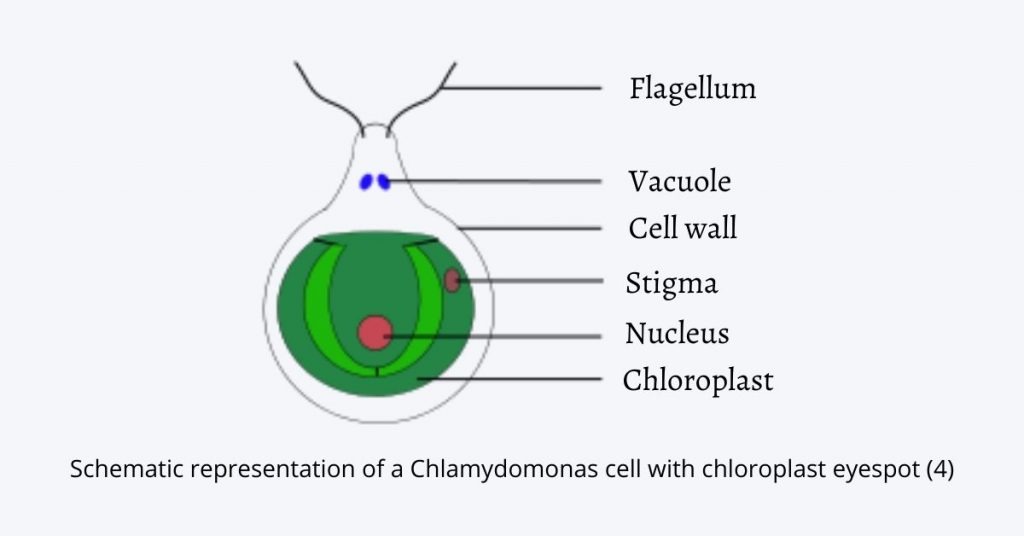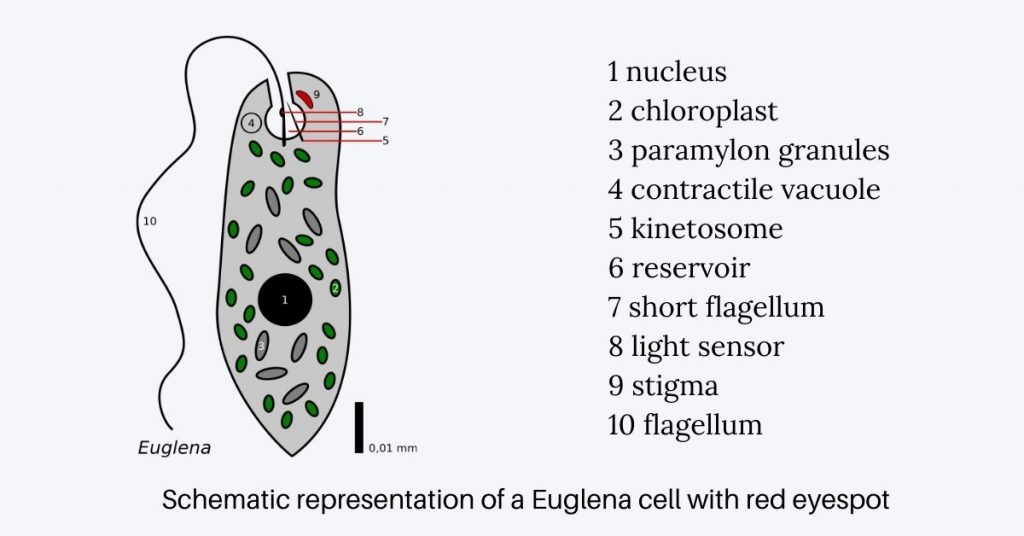How Are Eyespots Useful To Algae
Eyespot Definition
Eyespot also knew as the stigma, It is a photoreceptive organelle which is mainly plant in the motile class of green algae and in unicellular photosynthetic organisms for case euglenids.
Eyespot aid in cell's phototaxis, it senses the intensity and direction of low-cal source and responds to it. In response, it helps the organism in swim towards the lite (positive phototaxis), or away from it (negative phototaxis).
Nigh chiefly its main function is, it find out optimal low-cal conditions for the photosynthesis of cells.
Eyespot Structure

- The light microscope view of the eyespot appears as dark with orange-cherry-red spots or stigmata.
- The carotenoid pigments aid them to attain their colour which is independent within bodies known as pigment granules.
- They contain photoreceptors which are mainly found in the plasma membrane overlying the pigmented bodies.
- The electron Microscopic view appears as a highly ordered lamellar structure and is made by membranous rods in a helical organization.
- In Euglena the eyespot apparatus contains the paraflagellar trunk which connects the flagellum with the eyespot.
- In Chlamydomonas, information technology is a part of chloroplast which is takes on the appearance of a membranous sandwich structure.
- In Chlamydomonas they are made of chloroplast membranes (outer, inner, and thylakoid membranes) and carotenoid-filled granules which is covered by the plasma membrane.
- Stacks of granules on eyespot functions as quarter-wave plate and reflects the incoming photons back to the overlying photoreceptors, and also protects the photoreceptors from light coming from other directions.
- During the jail cell division, information technology dismantles and reformed again inside the girl cells in an asymmetric fashion in relation to the cytoskeleton which is essential for proper phototaxis.

Dissimilar Eyespot Proteins
- Eyespot senses light past using photoreceptor proteins, which are mainly found in unicellular organisms.
- These proteins has ii master groups such every bit flavoproteins and retinylidene proteins (rhodopsins).
- The flavoproteins carries flavin molecules as chromophores.
- The retinylidene proteins bear retinal.
- The Euglena photoreceptor poly peptide is a flavoprotein.
- The phototaxis in Chlamydomonas is carried out by an archaeal-type rhodopsins.
- Eyespot also contains different structural, metabolic and signaling proteins.
- In Chlamydomonas, the eyespot proteome is made of 200 different proteins.
The Photoreception and signal transduction
- The photoreceptor in Euglena is known as a blue-light-activated adenylyl cyclase, because on excitation these receptor proteins produces cyclic adenosine monophosphate (military camp) as a 2d messenger. Then the chemic signal transduction alters the flagellar vanquish patterns and as a consequence, the cell movement is occurring.
- In Chlamydomonas the archaeal-type rhodopsins carry all-trans retinylidene chromatophore which is photoisomerization to a 13-cis isomer. This leads to the activation of a photoreceptor channel, as a result, a alter occurs in membrane potential and cellular calcium ion concentration. The Photoelectric indicate transduction alters the flagellar strokes and results in cell motion.
Functions
- It detects the lite intensity and direction.
- It helps in the movement of Chlamydomonas towards the light source.
Types of Eyespot
There are present 5 types of eyespots such every bit Blazon A, Type B, Type C, Type D, and Type E.
- Type A
Information technology is a office of chloroplast merely not associated with flagella. Example: Chlorophyceae and cryptophyceae.
- Type B
It is a role of chloroplast but non associated with swollen flagella. Case: chrysophyceae ,xanthophyceae, phaeophyceae.
- Type C
These are independent clusters of osmophilic granules. Example: euglenophyceae.
- Type D
These are Osmophilic granules of eyespots and conatins membraneous structures Example: Dinophyceae.
- Blazon E
These are the largest eyespots composed of lens,retinoid and pigmented cups. Example: warnowiaceae family of dinophyceae.
Further Reading
- eleven Types of Algae With their example.
- Life cycle of Algae: Haplontic, Diplontic, Diplohaplontic, and Triphasic.
- Economic Importance of Algae: Food Industry, Chemical Industry, Agriculture, Medicine

 Scane to download
Scane to download
Download Microbiology Note App Download this app for free from google play store and read ads free notes
Need a Note? Request us Request
How Are Eyespots Useful To Algae,
Source: https://microbiologynote.com/eyespot-definition/
Posted by: haylessairse.blogspot.com


0 Response to "How Are Eyespots Useful To Algae"
Post a Comment